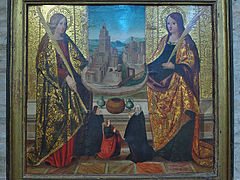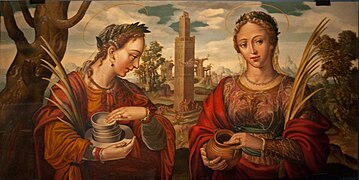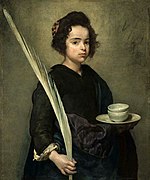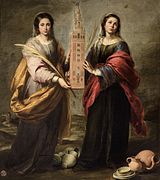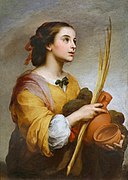Justa and Rufina
The two martyrs Justa and Rufina were sisters and, according to tradition, were born in the vicinity of Seville in the years 268 and 270; They suffered their martyrdom there under the Roman prefect Diogenianus in the year 287. Only St. Justa is mentioned in the Martyrologium Hieronymianum .
Lore
Justa ('the righteous') and Rufina ('the redhead') were born into a poor Christian family; Even as a child they helped their parents with the production of fine pottery, which they also sold in markets. One day when a pagan festival was held in honor of the goddess Salambo , they refused to sell their wares there. The mob then smashed all their wares; in return, the two sisters destroyed a figure of the goddess. Diogenianus ordered their arrest and - since they did not want to give up their Christian faith - their torture; eventually they were thrown into the dungeon hungry and without food.
The Martyrologium also reports that in the wake of Diogenianus they had to go barefoot towards the Sierra Morena ; on the way they were arrested again and taken to prison, where Justa was the first to die. Her body was thrown into a well, from which Bishop Sabinus later had her bones recovered. Diogenianus now hoped that Rufina would give in, but when she refused again, he had her thrown to a lion to eat, which however remained peaceful. Thereupon Diogenianus had Rufina strangled or beheaded; her subsequently burned body was also recovered by Bishop Sabinus.
Adoration
Several churches in Spain ( Madrid , Maluenda , Orihuela , Toledo ), but also the parish church of Prats-de-Mollo , French since the Peace of the Pyrenees (1659), bear the patronage of the saints; her feast day is July 19th . The saints, venerated as patron saints of Seville, but also in other parts of the Iberian Peninsula , are usually represented together in the iconography.
The earliest (preserved) representations of the two saints date from the 15th century. Later they were regularly depicted with the Giralda , which they prevented from collapsing in the earthquakes of 1508 and 1755. Attributes are also pottery or destroyed ancient portraits.
Santa Rufina by Diego Velázquez (around 1635)
Santa Rufina by Francisco de Zurbarán (around 1640)
Hll. Justa and Rufina by Bartolomé Esteban Murillo (around 1665)
See also
The destruction of pagan sculptures by Christians (and vice versa) led to frequent conflicts at the time when Christianity was beginning to flourish. A resolution of the Synod of Elvira (around 300) read accordingly: Anyone who smashes an idol and is killed in the process or for it must not be regarded as a martyr, since the Gospels do not mention anything like that.
Web links
- Justa and Rufina, Ecumenical Lexicon of Saints - pictures + information
- Santa Justa, painting by Bartolomé Esteban Murillo (around 1665) - photo + information (English)
- Santa Rufina, painting by Bartolomé Esteban Murillo (around 1665) - photo + brief information (English)
Individual evidence
- ↑ Thomas Pekáry : Imago res mortua est. Studies on the Rejection of Fine Arts in Antiquity. Franz Steiner Verlag, Stuttgart 2002, ISBN 978-3-515-08248-8 , pp. 92ff [1]

